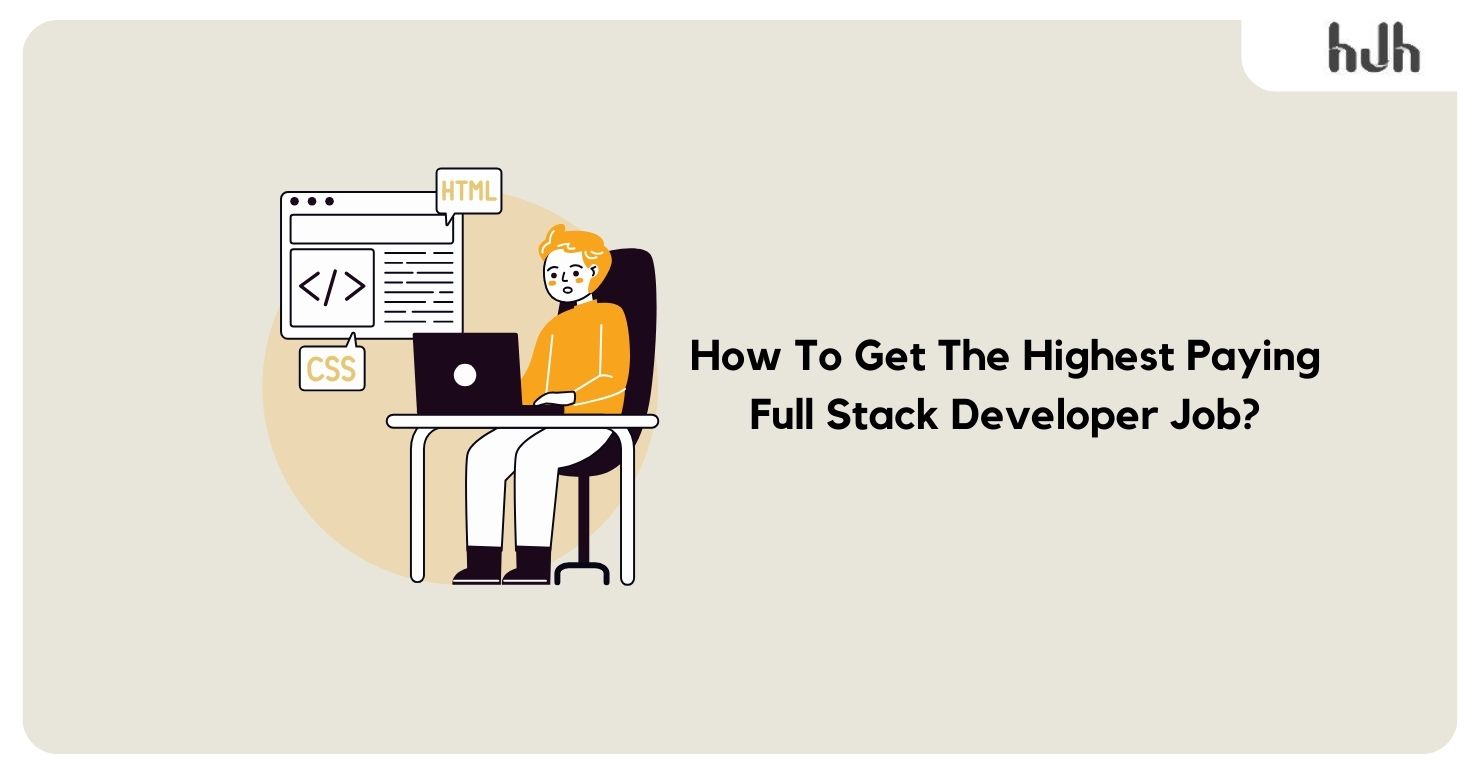Are you wondering about ‘how to become a full stack developer’ and land the highest-paying job in the field?
With the average salary for experienced full-stack developers reaching upwards of ₹21,00,000 per year, mastering the art of full-stack development not only opens doors to lucrative opportunities but also promises a rewarding professional journey.
However, the path to securing the highest-paying positions isn’t just about coding prowess—it’s a strategic journey that involves a blend of technical expertise, soft skills, and a keen understanding of market demands.
In this comprehensive guide, we’ll unravel the blueprint for ‘how to become full stack web developer’ and achieving the pinnacle of success in this niche. Get ready to uncover the essential steps, insider tips, and expert strategies that will position you at the forefront of the industry, commanding the highest compensation for your exceptional skills.
Table of Contents
I. Strategies to Land High-Paying Full-Stack Developer Jobs
- A. Building a Strong Portfolio
- B. Continuous Learning and Skill Enhancement
- C. Networking and Building Professional Relationships
II. Salary Trends and Statistics in Full Stack Development
- A. Average salaries based on education, experience, roles, and location
- B. Companies offering the highest-paying opportunities
- C. Future projections and trends in full-stack development salaries
III. Tips for Nailing Full Stack Developer Job Interviews
IV. Negotiating and Securing a High-Paying Job Offer
- A. Researching salary expectations and market rates
- B. Strategies for negotiating salary and benefits
- C. Evaluating job offers based on overall benefits and growth potential
V. Conclusion
I. Strategies to Land High-Paying Full-Stack Developer Jobs
Here, we’ll delve deep into the winning strategies on ‘how to be a full stack developer’ that will set you on the path to securing high-paying full-stack developer positions. Additionally, we’ll uncover the importance of networking, building a standout portfolio, and honing your stack developer skills concurrently.
A. Building a Strong Portfolio
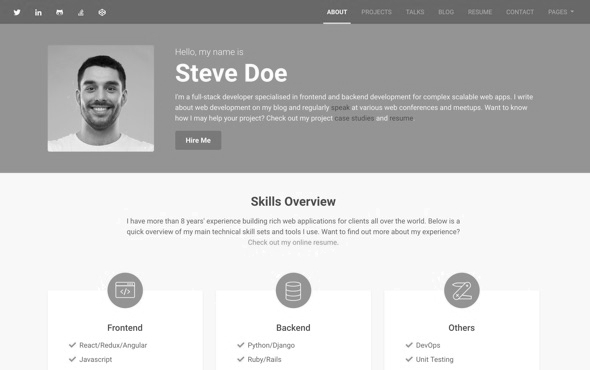
Follow these steps to craft a portfolio that speaks volumes about your capabilities:
#1 Curate Diverse Projects
Firstly, you need to build a portfolio that helps you stand out in the ‘how to get a developer job’ race by highlighting your strengths. Include a variety of projects that showcase your proficiency across different technologies and aspects of full-stack development.
For instance, craft an innovative website or application leveraging full-stack technology, drawing inspiration from various blogs. It’s crucial to incorporate robust authentication features, allowing access only to individuals with valid credentials to log in securely to the platform.
Example Source Code: Blog Website – GitHub
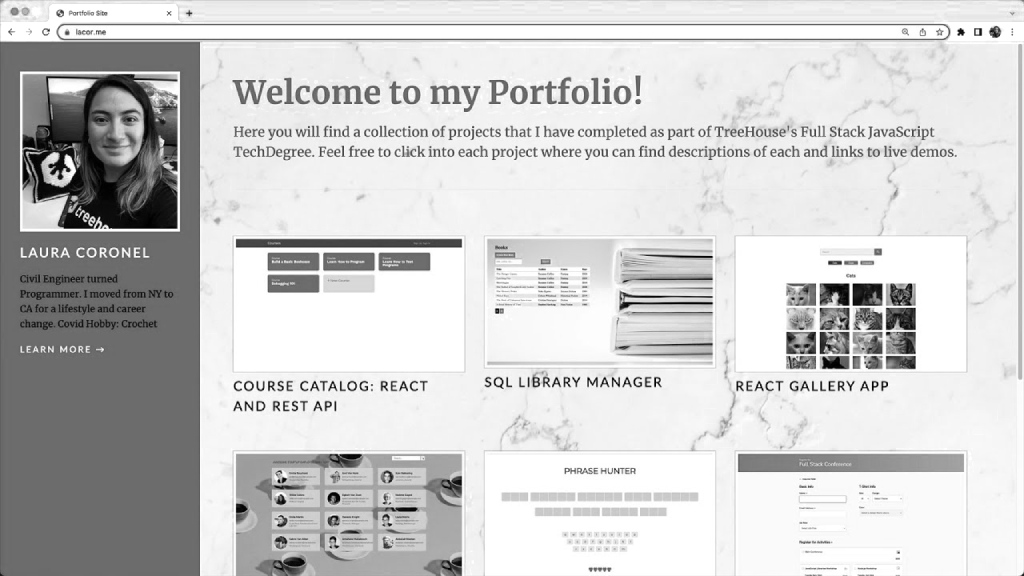
#2 Highlight Problem-Solving Skills
Emphasize projects where you solved real-world problems. For instance, a project that involved optimizing database performance or creating a scalable application architecture.
Example Source code: Yield farming optimizer for Binance Smart Chain
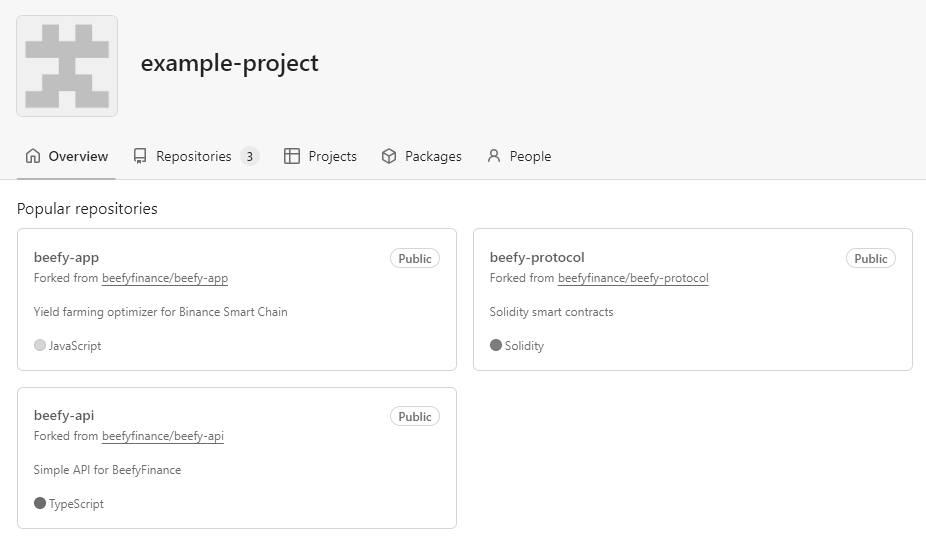
#3 Include Clean Code Samples
Provide snippets of your code to exhibit your coding style, commenting practices, and adherence to best practices.
Example Source code: Create code snippets
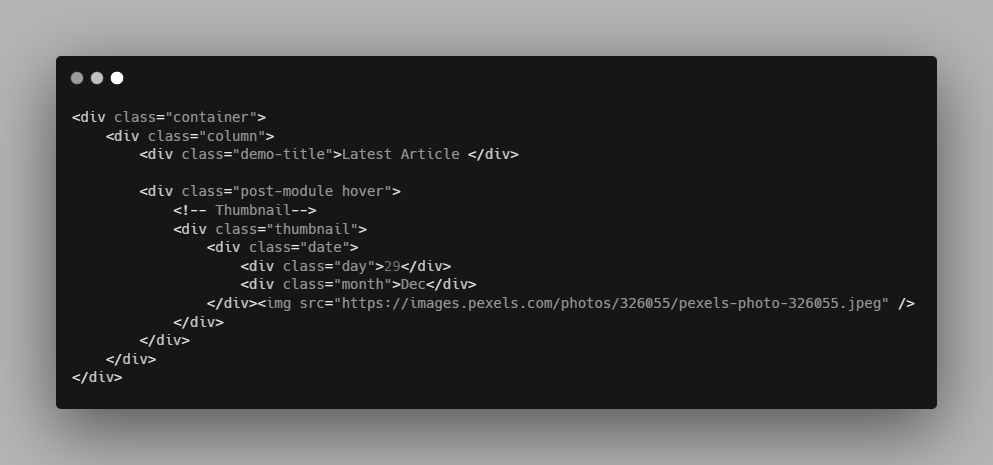
#4 Demonstrate Collaboration
If you’ve collaborated on projects, specify your role and contributions. Link to repositories or platforms where your collaborative work is showcased.
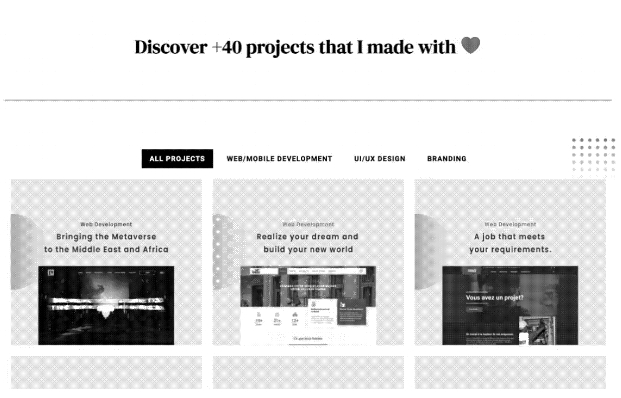
#5 Design a User-friendly Portfolio Website
Create a visually appealing website to display your projects. Use platforms like GitHub Pages, or build a custom site using HTML/CSS/JavaScript or frameworks like Bootstrap or Vue.js Example Source code: Portfolio Website Template
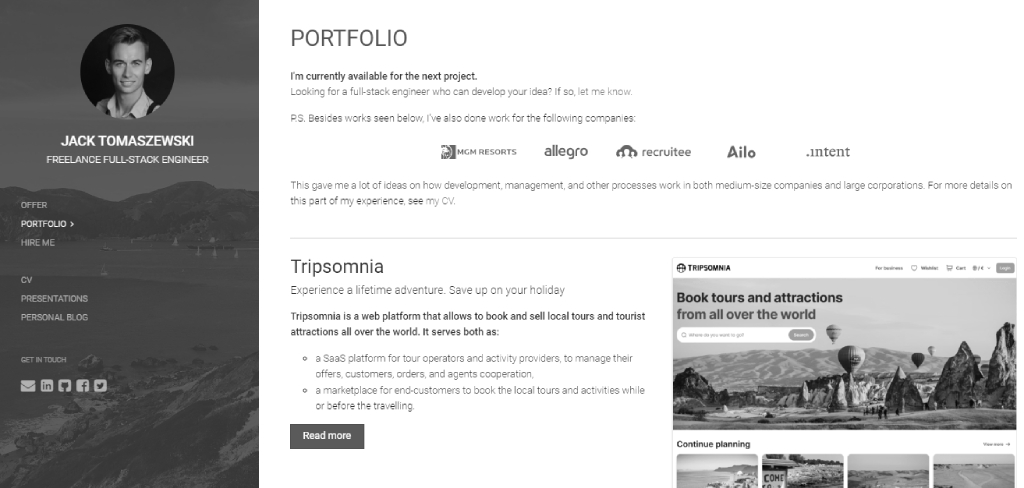
#6 Optimize for Mobile Responsiveness
Ensure your portfolio website is optimized for various devices, showcasing adaptability and attention to user experience
Example Source code: Responsive design.
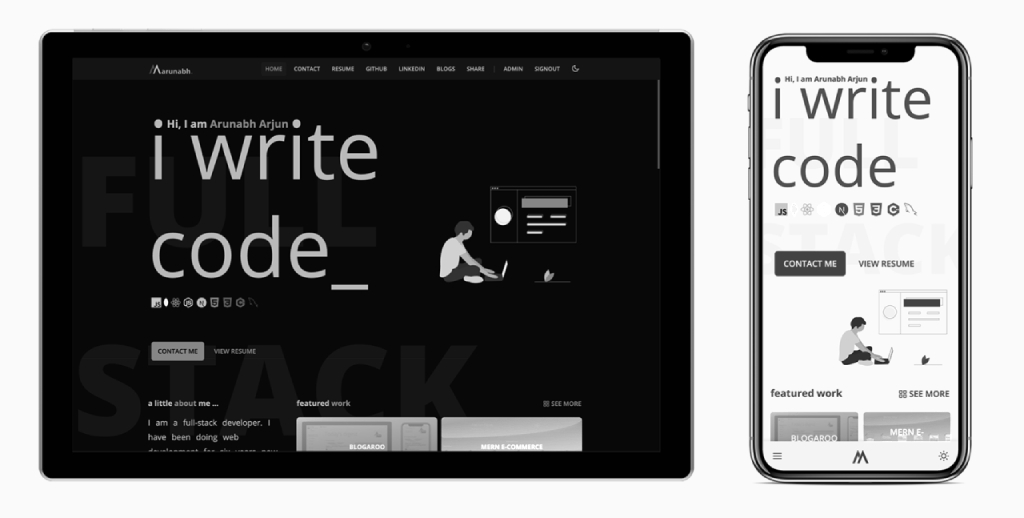
#7 Quantify Achievements
Where possible, include metrics or results achieved through your projects, such as increased site traffic, improved load times, or positive user feedback
Example Source code: Project Metrics.
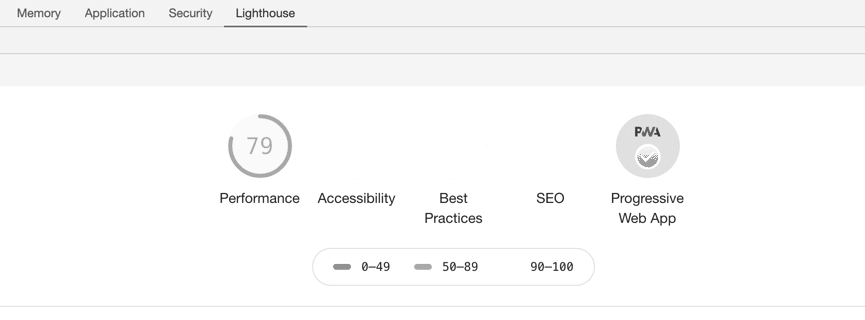
B. Continuous Learning and Skill Enhancement
You need to ensure that your skillset remains competitive. The tech landscape evolves rapidly, you need to stay up-to-date with the latest tools and skills, strengthen your abilities and to and keep your resume relevant in the competitive ‘how to get a job as a web developer’ market.
#1 Stay Updated with Latest Technologies
Regularly explore emerging technologies and trends in full-stack development. Follow reputable tech blogs on ‘how to become a full stack software engineer’, attend webinars, and enroll in online courses to stay ahead.
Example: Tech blog.
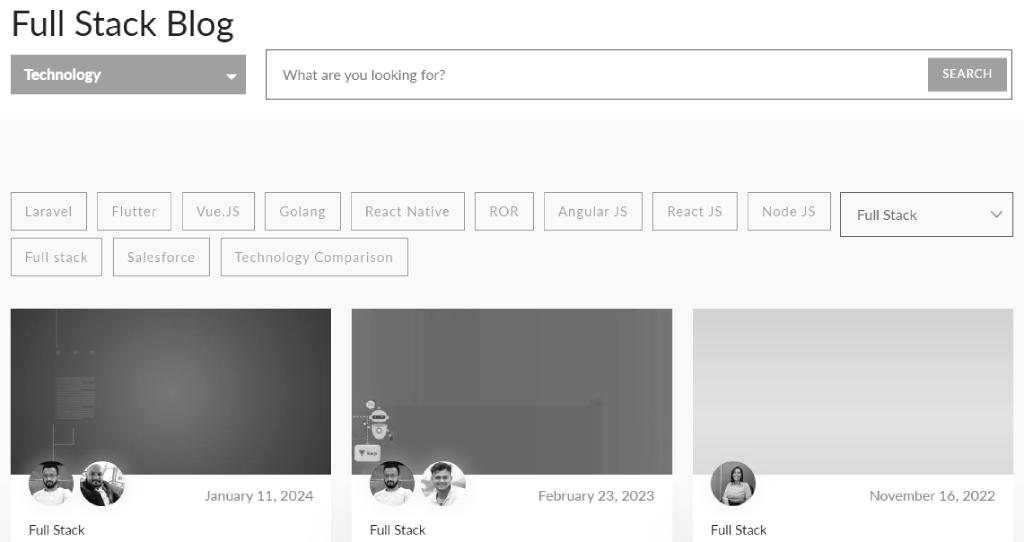
#2 Master In-Demand Programming Languages
Strengthen your proficiency in languages like JavaScript, Python, and Java, which are highly sought after in full-stack roles.
Example: Programming language learning resources.
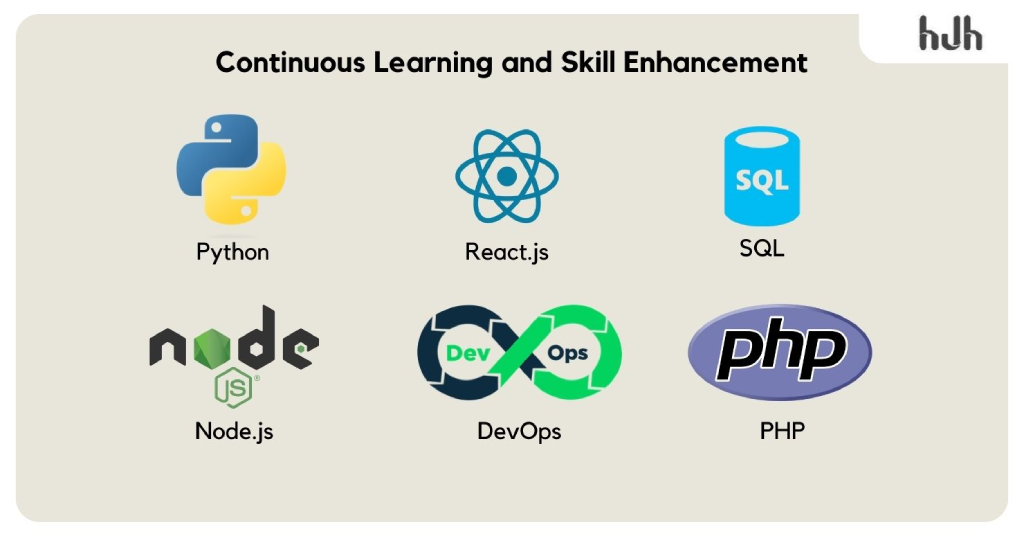
#3 Familiarize with Frameworks and Libraries
Acquire expertise in popular frameworks and libraries such as React, Angular, Node.js, Django, or Flask, as they significantly enhance your development capabilities.
Example: React Documentation.
Source code: React sample project

#4 Explore Cloud Technologies
Gain proficiency in cloud computing platforms like AWS, Azure, or Google Cloud as they are integral to modern application development.
Example: [AWS Training](https://aws.amazon.com/training/).
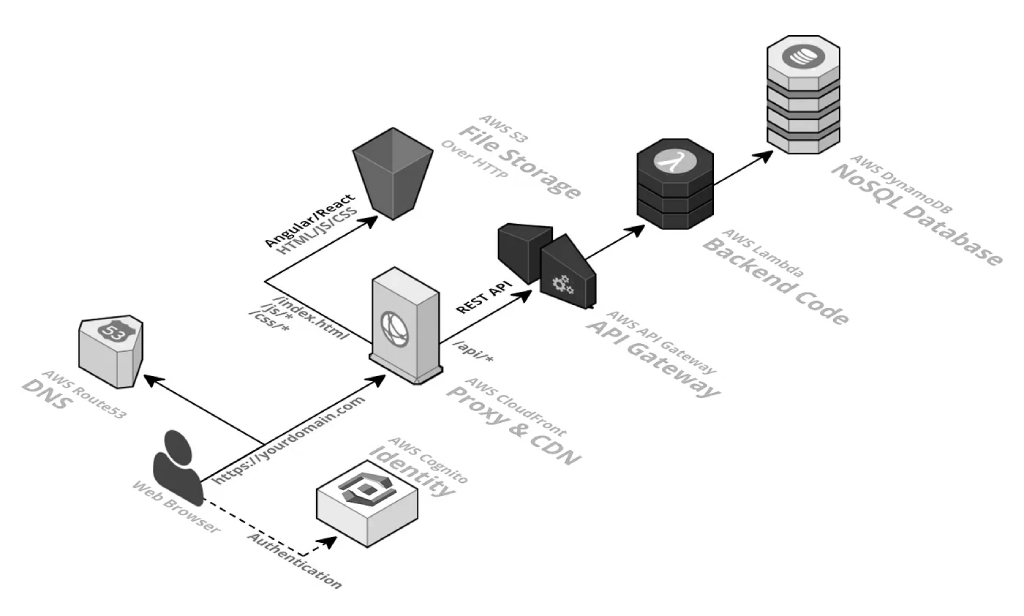
#5 Develop Soft Skills
Sharpen your communication, problem-solving, and teamwork skills. Employers highly value developers who can effectively collaborate and communicate ideas.
Example: Communication skills.
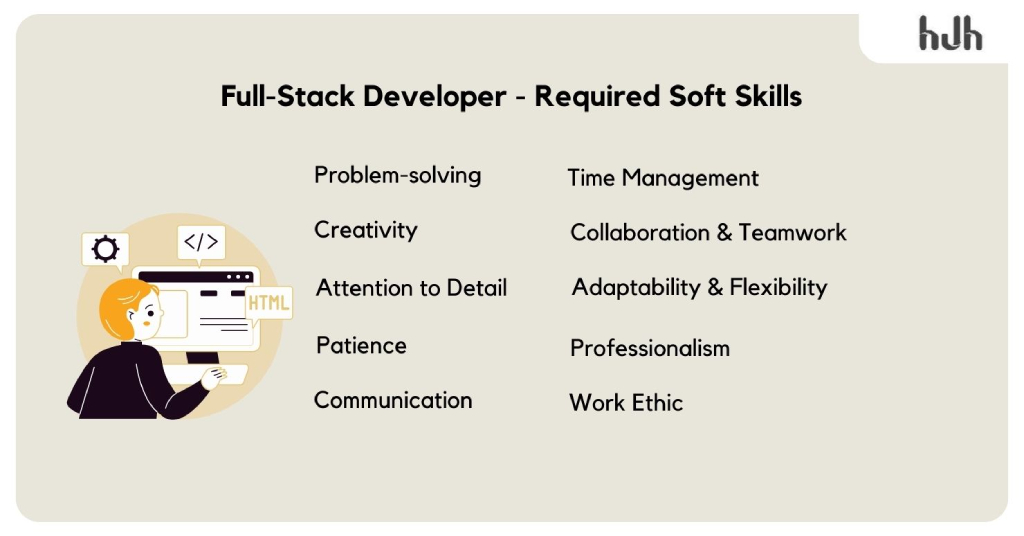
#6 Contribute to Open Source Projects
Engage in open-source projects to not only contribute to the community but also enhance your visibility and experience.
Example: GitHub open source projects.
#7 Build Specialized Knowledge
Consider specializing in areas like cybersecurity, machine learning, or DevOps, as these niche skills can set you apart and demand higher compensation.
Example: DevOps.
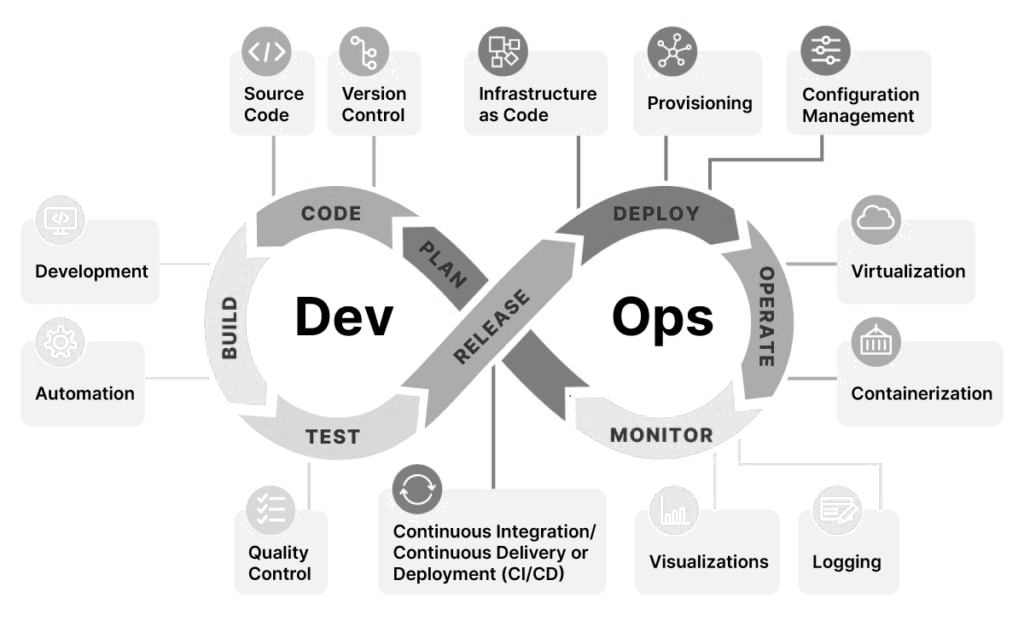
C. Networking and Building Professional Relationships
Networking isn’t just about making connections; it’s about fostering meaningful relationships and contributing value to the community. Learn how to leverage these connections to give yourself a competitive edge in the ‘how to get a web developer job’ market.
#1 Engage in Developer Communities
Join online forums, and communities like Stack Overflow, GitHub, or Reddit, and participate actively. Engaging in discussions and contributing valuable insights helps you build a strong presence.
Example: Stack Overflow Developer Community.
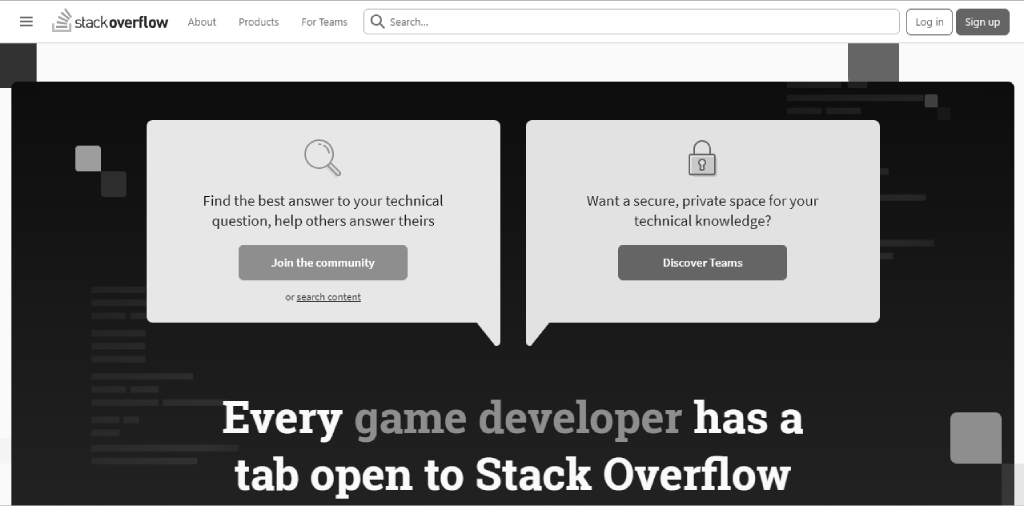
#2 Attend Tech Meetups and Conferences
Attend industry events, tech meetups, and conferences both in-person and virtually. These platforms offer excellent opportunities to network, learn, and engage with industry leaders. Check out the event sites like in the given example here.
Example: Tech conference listings.
#3 Utilize LinkedIn Effectively
Optimize your LinkedIn profile to showcase your skills, projects, and achievements. Connect with professionals, recruiters, and peers in the field. Engage by sharing insights and articles to enhance your visibility.
Example: LinkedIn profile tips.
#4 Contribute Through Blogging or Speaking
Share your knowledge and insights by writing tech blogs, contributing to industry publications, or speaking at events. This not only establishes credibility but also expands your network.
For instance, when you visit the sample link given below, you will land on the platform where various technology experts like you share the most insightful stories. Likewise, you can also publish, share, follow, connect, and grow your community presence.
Example: Medium tech publication.

#5 Seek Mentorship or Guidance
Connect with experienced developers or mentors who can provide guidance and advice. Platforms like MentorCruise or LinkedIn can be valuable for finding mentors who can train you exclusively through 1-on-1 programs.
Example: MentorCruise.

Remember, building a strong network can lead to referrals, job opportunities, and access to insider information, all of which are instrumental in landing high-paying full-stack developer roles.
II. Salary Trends and Statistics in Full Stack Development
Under this heading, dive into an exploration of the current salary landscape, understanding the factors that influence pay scales, and gaining insights into regional variations and specializations that command higher compensations.
A. Average salaries based on education, experience, roles, and location
#1 Entry Level Salary
In December 2023, AmbitionBox reported that entry-level full-stack software developers earned an average yearly salary nearing ₹1.8 lakhs. This corresponds to roughly ₹86.54 per hour and approximately ₹3461.54 per week.
#2 All-Levels Average Salary
On the other hand, as per Glassdoor’s recent reports, the average annual wage for web developers across all experience levels stood notably higher, averaging between ₹9,00,000 and ₹21,00,000 annually. This includes the Base pay ranging from ₹4,00,000 up to ₹10,00,000 and the Additional pay range between ₹32,000 and ₹1,10,803.
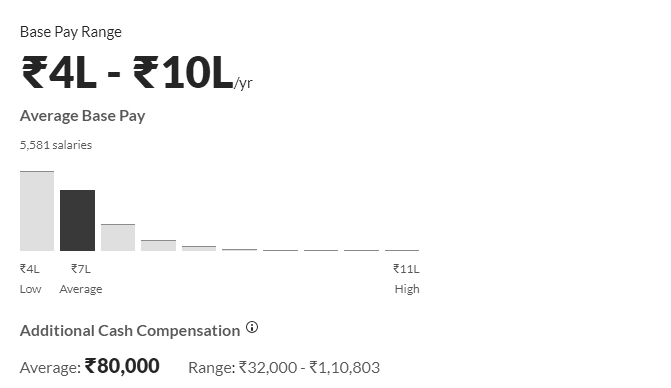
#3 Salary by Education
Below, you’ll find the average salary difference among various educational levels for professionals in the role of Full Stack Developer.
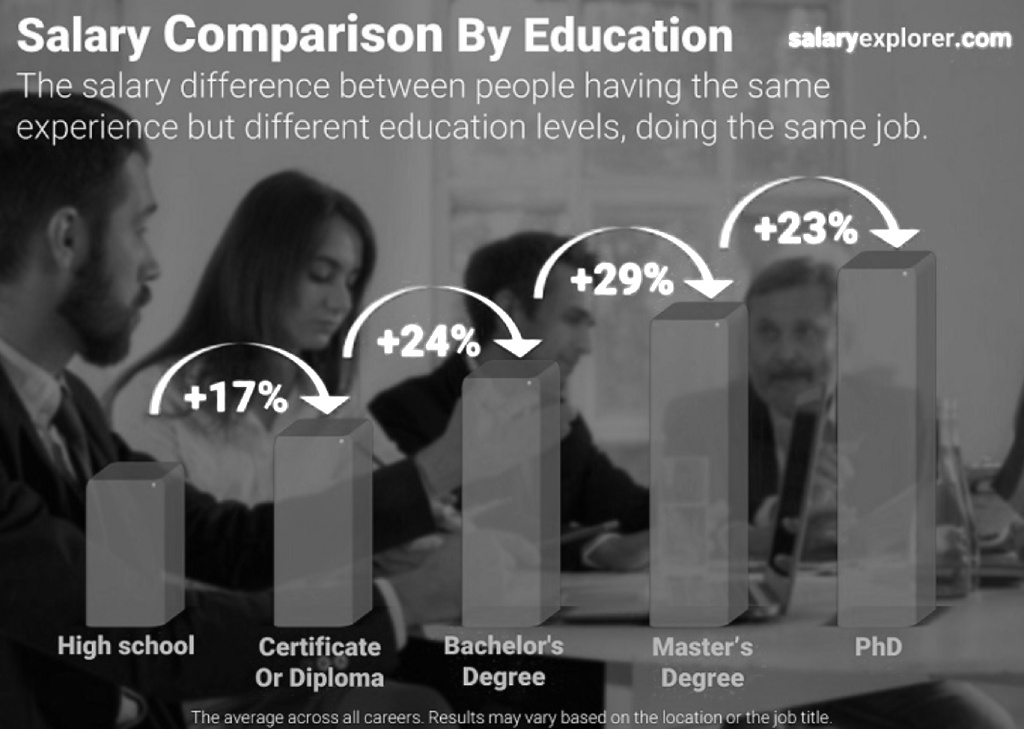
Salary by Programming Language
| Programming Language | Average Salary (Monthly) |
| Full-stack WordPress Developer | ₹40,000 |
| Full-stack JavaScript Developer | ₹53,333 |
| Full-stack PHP Developer | ₹30,000 |
| Full-stack Ruby on Rails Developer | ₹52,500 |
| Full-stack Python Developer | ₹45,333 |
| Full-stack Java Developer | ₹64,167 |
#4 Salary by Roles
| Role | Average Hourly Pay | Average Yearly Pay |
| Full-Stack Web Developer | ₹317.31 | ₹6.6 Lakhs |
| Full-Stack JAVA Developer | ₹370.19 | ₹7.7 Lakhs |
| Full-Stack Engineer | ₹413.46 | ₹8.6 Lakhs |
| Full-Stack Software Developer | ₹451.92 | ₹9.4 Lakhs |
| Full-Stack JavaScript Developer | ₹307.69 | ₹6.4 Lakhs |
#5 Salary by Location
Salaries of full-stack developers in larger cities often correlate with higher compensation due to increased living costs. Here are some of the highest-paying cities for full-stack developers, showcasing their average annual salaries:
- Delhi – ₹7.38 lakhs
- Bombay, Maharashtra – ₹8.71 lakhs
- Kolkata, West Bengal – ₹5.60 lakhs
- Pune, Maharashtra – ₹8.75 lakhs
- Bengaluru, Karnataka – ₹9.11 lakhs
- Hyderabad, Telangana – ₹9.47 lakhs
- Chennai, Tamilnadu – ₹7.67 lakhs
- Visakhapatnam, Andhra Pradesh – ₹7.31 lakhs
- Indore, Madhya Pradesh – ₹6.69 lakhs
- Ahmedabad, Gujarat – ₹7.22 lakhs
These cities, known for their vibrant tech scenes and thriving industries, tend to offer higher compensation packages to full-stack developers to accommodate the increased costs associated with living and working in these metropolitan areas.
B. Companies offering the highest paying opportunities
Uncover the companies that consistently lead in paying top salaries to full-stack professionals, providing you with valuable direction for career growth and financial advancement.
| Company | Average Annual Salary |
| TCS | ₹5.8 Lakhs |
| Cognizant | ₹8.3 Lakhs |
| IBM | ₹13.9 Lakhs |
| Accenture | ₹9 Lakhs |
| Infosys | ₹6.5 Lakhs |
| Wipro | ₹7.1 Lakhs |
| Capgemini | ₹6.4 Lakhs |
| Deloitte | ₹14.2 Lakhs |
| Verizon | ₹18 Lakhs |
Recommended read: Remote Coder Companies Hiring for Medical Coding Jobs
C. Future projections and trends in full-stack development salaries
As the demand for full-stack developers intensifies each day, the job market is witnessing a surge in opportunities. Recent years have seen a remarkable increase in available positions for full-stack developers. This growth can be attributed to the burgeoning trend of cross-platform development and the expanding realm of cloud computing.
Understanding these evolving trends is key to anticipating continued growth in both job availability and competitive salaries if you’re wondering about ‘how to get hired as a web developer.’
Full-stack development is a key part of advanced technology and is a highly sought-after job worldwide. In the last year, the demand for full-stack developers in India has increased by over 30%.
Additionally, insights from the US Bureau of Labor Statistics predict a substantial surge in job opportunities for professionals in this field. Projections indicate a significant rise, from 135,000 positions to an estimated 853,000 jobs available for full-stack developers by 2024.
Adding to it, the data from the Bureau of Labor Statistics projected growth for the position of web developer between 2018 and 2028 stands at 13%, significantly outpacing the average growth rate for occupations overall.
These stats denote that a full-stack developer job is one of the highest-paid roles globally, and the demand seems to be soaring day by day.
III. Tips for Nailing Full Stack Developer Job Interviews
A. Preparing for technical interviews
When gearing up for technical interviews that can secure you the highest-paying full-stack developer position, meticulous preparation is key. Follow these steps to excel in the technical rounds:
#1 Understand Core Concepts
Revisit fundamental concepts in data structures, algorithms, and problem-solving. Platforms like Geeksforgeeks, Interview Cake, CodeChef, etc., offer a plethora of coding challenges to sharpen your skills.
#2 Review Company Technologies
Investigate the technologies and frameworks used by the company you’re interviewing with. Familiarity with the common industry-utilized tech stack, such as React, Node.js, or Django, showcases your alignment with their needs.
#3 Build Real-World Projects
Showcase your practical skills by developing complete, real-world projects on open platforms for displaying your coding prowess. Refer to these samples:
- GitHub: Host code repositories and collaborate on projects.
- Bitbucket: Offers version control, code collaboration, and continuous delivery within a single platform.
- SourceForge: An open-source platform providing version control and collaboration tools for software development.
- AWS CodeCommit: A fully managed source control service hosted by Amazon Web Services, integrated with other AWS tools.
#4 Stay Updated on Industry Trends
Demonstrate your awareness of the latest industry trends by staying informed about advancements in full-stack development.
- Smashing Magazine: Blogs that provide insightful articles and resources on web development and design.
- CSS-Tricks: Offers articles, tutorials, and resources on CSS, HTML, JavaScript, and front-end development.
- Dev.to: A community-based platform where developers share knowledge, experiences, and insights through articles and discussions.
- MDN Web Docs: Mozilla’s resource provides comprehensive documentation and guides on web technologies.
#5 Mock Interviews with Peers
Conduct practice interviews with peers or mentors to simulate real-time scenarios. Check out these platforms.
- Pramp: Facilitates mock interviews with fellow developers. Plus, practice coding skills for free.
- Interviewing.io: Here, you can give anonymous technical interviews with engineers from top tech companies for coding practice and interview preparation.
- LeetCode Discuss: Utilize the discussion forums on LeetCode for mock interviews, coding challenges, and interview experiences shared by the community.
- AlgoExpert: Offers coding interview preparation through curated problems and video explanations.
- CoderPad: Allows collaborative coding interviews and code collaboration in real-time for technical assessments.
#6 Review Past Work and Projects
Be prepared to discuss and elaborate on your past work. Understand the decisions made, challenges faced, and solutions implemented. This demonstrates your experience and thought process.
#7 Ask Questions and Seek Clarifications
During the interview, don’t hesitate to ask questions or seek clarification. This not only demonstrates your analytical thinking but also ensures a clear understanding of the problem at hand.
By diligently preparing for technical interviews with a focus on both theoretical knowledge and practical application, you position yourself as a well-rounded full-stack developer ready to take on the challenges of the highest-paying positions in the industry.
B. Showcasing soft skills and problem-solving abilities
To secure the highest paying positions as a full-stack developer, honing both technical expertise and soft skills is crucial. Here are essential qualities you should possess:
#1 Communication Skills
Clear and effective communication is vital. Presenting technical concepts concisely and collaborating seamlessly with teams is key. Simply click on any of these links to train and improve those essential soft skills right from wherever you are.
- LinkedIn: Get industrial insights into developing technical communication directly on this job board.
- Skillshare: Provides classes and workshops on communication strategies, including technical communication for professionals.
- The Muse: Offers articles and resources on improving communication skills, including technical communication in the workplace.
- Toastmasters International: Provides guidance and resources for improving public speaking and communication skills.
- EdX: There are courses on communication and presentation skills, including technical communication and effective messaging.
#2 Creativity and Innovation
Highlight instances where you’ve creatively solved problems or introduced innovative solutions in your projects. Or, you can upload them as articles on platforms like,
- SitePoint: Explore creative approaches in development.
- A List Apart: Focuses on web design, development, and content creation, featuring in-depth articles and insights.
- DigitalOcean’s Community Tutorials: This serves as a welcoming space where developers can seek or offer support and explore fresh avenues to actively contribute to the community.
#3 Team Collaboration and Leadership
Illustrate instances of successful teamwork or leadership roles in projects. Show how you effectively collaborated on GitHub repositories.
#4 Time Management and Prioritization
Emphasize your ability to manage deadlines and prioritize tasks effectively. Techniques from productivity blogs like Todoist can be valuable. Need more?
- Asana Blog: Provides insights, tips, and best practices for project management, productivity, and teamwork.
- Evernote Blog: Find articles and tools to help you with productivity, note-taking, and organization to boost efficiency.
- Lifehacker: Get a variety of articles and daily tips on productivity, technology, and life hacks for efficiency.
#5 Emotional Intelligence
Demonstrate empathy, patience, and the ability to work under pressure. Resources on platforms like MindTools, provide guidance on emotional intelligence in the workplace. Here are a few more:
- Harvard Business Review: Ideas, insights, and resources for your management, leadership, and professional development.
- Coursera: Learn online courses from universities and institutions covering various topics in personal and professional development.
- Udemy: One more online academy that offers a wide range of online courses on personal development, leadership, and soft skills.
By amalgamating technical prowess with these soft skills and problem-solving abilities, you present a well-rounded profile that resonates with employers seeking technical expertise and collaborative and adaptable full-stack developers for their highest-paying roles.
Recommended read: Guide For One Way Interviews With Everything You Need to Know
IV. Negotiating and Securing a High-Paying Job Offer
A. Researching salary expectations and market rates
When aiming for a high-paying job offer, thorough research on salary expectations and market rates is pivotal. Here’s what you need to do:
#1 Online Research
Utilize reliable online resources such as Glassdoor and PayScale to explore industry-standard salaries for similar positions in your location. There are more such sites:
- Salary.com: A platform for salary data, tools, and resources for individuals and businesses.
- Bureau of Labor Statistics (BLS): Visit this site for official government data on wages, employment, and industry trends.
- Indeed Salaries: Browse top-paying industries, salary insights and trends and more based on job postings and employee-reported data.
- Comparably: If you are curious about getting insights into company salaries, culture, and workplace sentiment, then Comparably is the place.
#2 Company Insights
Investigate salaries offered by the specific companies you’re considering. Some companies disclose salary bands on platforms like
- Levels.fyi: Explore salaries, benefits, and more company-wise. See who is offering the best pay in your industry.
- Blind: Access real salary insights shared by verified employees. You can even track information on Return to Office (RTO), hybrid, and fully remote companies as well.
- Fishbowl: Professional networking platform for verified employees to discuss workplace topics and career insights even without disclosing your identity.
- Reddit: Subreddits like r/careeradvice, r/jobs, and company-specific subs often have discussions about workplaces, salaries, and career insights.
- Robert Half: Refer to industry-specific reports or surveys that detail salary benchmarks.
#3 Consider Total Compensation
The entire compensation package for a full-stack developer typically includes various components beyond the base salary. Here are the parameters often considered:
- Base Salary: The fixed amount paid regularly to the employee, usually on a monthly basis.
- Bonuses: Includes additional monetary rewards given based on performance, often tied to individual or company performance metrics.
- Stock Options or Equity Grants: Check whether the company offers any ownership stakes as part of the compensation, allowing employees to buy company shares or restricted stock units (RSUs) at a set price.
- Benefits Package:
- Health Insurance: Coverage for medical, dental, and vision expenses.
- Retirement Plans: Such as pension plans.
- Paid Time Off (PTO): Including vacation days, sick leave, and holidays.
- Flexible Spending Accounts (FSA) or Health Savings Accounts (HSA): Pre-tax savings for medical expenses.
- Life Insurance and Disability Coverage: Providing financial protection in adverse circumstances.
- Tuition Reimbursement or Professional Development: Support for further education or skill enhancement.
- Perks:
- Remote Work Options: Flexibility to work from home or other locations.
- Company Car or Transportation Allowance: Assistance with commuting expenses or a company vehicle.
- Gym Memberships, Wellness Programs, or Employee Assistance Programs (EAP): Supporting employee well-being.
- Relocation Assistance or Sign-On Bonuses: For employees relocating for the job or as an incentive to join the company.
- Flexible Work Schedule or Work-Life Balance Programs: Options for flexible hours, compressed workweeks, or parental leave policies.
- Severance Packages: In case of employment termination, this includes benefits such as severance pay, continuation of health benefits, or career transition support.
It’s important to note that the specific details of the compensation package can vary between companies and depend on factors like the company’s size, industry, and location. Candidates should carefully review and negotiate the terms of their compensation packages based on their individual needs and priorities.
#4 Local Cost of Living
As we have discussed earlier in this article your salary directly accounts for the cost of living in your area. Consider the local cost of living when negotiating your full-stack developer salary in India.
Salaries may vary based on the city’s living expenses. In high-cost cities like Mumbai or Bangalore, employers often offer higher salaries. Check platforms like Indeed, Glassdoor, PayScale, or LinkedIn for city-specific salary insights before your negotiation.
#5 Prepare Your Range
Based on the data given in this article, work out and establish a salary range that aligns with your skills, experience, and the market value of the role.
B. Strategies for negotiating salary and benefits
Follow these essential strategies when negotiating salary and benefits to perfectly land that high-paying job offer:
#1 Research and Preparation
First, utilize salary research from any of the platforms given in the previous sections, to understand industry standards. Compile a list of your accomplishments and contributions to showcase your value.
#2 Highlight Unique Value
Emphasize unique skills, certifications, or experiences that set you apart. Showcase how these attributes bring added value to the role.
#3 Focus on Total Compensation
Negotiate beyond the base salary. Discuss bonuses, stock options, benefits, and other perks that contribute to the total compensation package. Refer to the “Consider Total Compensation” para above for the full list of parameters.
#4 Set Realistic but Ambitious Goals
Present a salary range based on research, indicating flexibility but aiming for a figure that aligns with your worth.
#5 Timing and Context Matter
Time your negotiation appropriately, preferably after receiving the job offer. Express enthusiasm for the role before delving into negotiations.
#6 Effective Communication
Clearly articulate your case, remaining confident but respectful. Use active listening and ask questions to understand the employer’s perspective.
#7 Consider the Company’s Perspective
Understand the company’s financial health and budget constraints. Tailor your negotiation requests accordingly.
#8 Negotiate for Future Growth
Discuss opportunities for performance reviews, career advancement, or skill development to compensate if the initial offer isn’t flexible.
#9 Have Alternatives Ready
Be prepared to negotiate non-monetary benefits if salary adjustments aren’t possible. For instance, remote work options, additional vacation days, or professional development opportunities.
#10 Follow-Up in Writing
Once an agreement is reached, ensure the terms discussed are documented in the offer letter or contract.
By implementing these strategies effectively, you can negotiate a comprehensive and competitive compensation package aligned with your skills, experience, and the market value of the role as a full-stack developer.
C. Evaluating job offers based on overall benefits and growth potential
Evaluating job offers based on overall benefits and growth potential involves several considerations. Here’s how you can assess them:
#1 Comprehensive Compensation
Remember again to look beyond the base salary. Consider bonuses, stock options, benefits, and other perks. Tools like Salary.com can aid in understanding the value of different components.
#2 Career Advancement Opportunities
Secondly, assess growth prospects within the company. Research if the company encourages and supports career development. Platforms like LinkedIn can provide insights into career paths within specific organizations.
#3 Company Culture and Values
Evaluate if the company’s values align with yours. Portals similar to The Muse offer insights into company culture through employee reviews and stories.
#4 Work-Life Balance
Consider flexibility in work hours, remote work policies, and company support for maintaining a healthy work-life balance. Employee reviews on Glassdoor can provide insights into this aspect.
#5 Training and Development
Assess if the company invests in employee training, certifications, or skill development programs. Research industry-specific reports from sources like Robert Half for insights into training trends.
#6 Company Stability and Reputation
Investigate the company’s financial stability and reputation within the industry. Look at news articles or financial reports from credible sources like Bloomberg.
Here are some alternatives to Bloomberg for business, financial news, and market analysis:
#7 Employee Benefits and Wellness Programs
Analyze the quality of healthcare, retirement plans, wellness initiatives, and other employee benefits. Company websites often detail these offerings.
#8 Feedback from Current Employees
Engage with current or former employees if possible. Platforms like Blind provide anonymous insights into workplace experiences.
By considering these factors holistically and evaluating how each job offer aligns with your long-term career goals, values, and growth aspirations, you can make an informed decision that ensures a high-paying job and a fulfilling and progressive career trajectory.
Conclusion
In your journey of ‘how to get a job in web development’, remember that getting the highest paying full-stack developer job is not just about the paycheck but about finding a role that aligns with your skills, values, and growth aspirations.
By showcasing your expertise, continually learning, networking wisely, and negotiating thoughtfully, you’re not just aiming for a paycheck; you’re sculpting a fulfilling career.
Keep exploring, keep innovating, and keep pushing the boundaries. The highest-paying job isn’t just about the numbers; it’s about finding your place in an ever-evolving tech landscape, where your skills shine and your career flourishes.
Your journey to the top isn’t just about the destination—it’s about the incredible experience and growth along the way.
